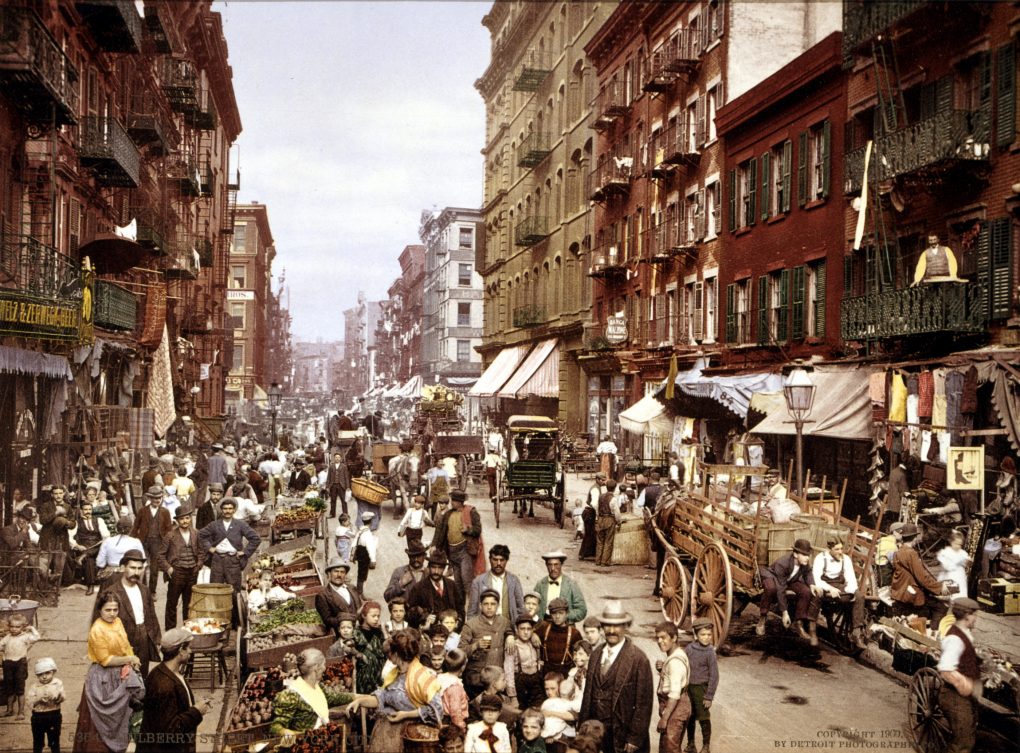
As controversy and debate rage over the statue of Columbus in NYC and the fate of Columbus Day generally, today might be a good moment for Italian Americans (and others) to ponder the dilemmas and paradoxes of Italian American history. In co-editing a new book, we have come to see Columbus as a prism through which much of Italian American history is refracted and often times distorted. If, in 1917, someone would have made the daring prediction that not one but two Italian Americans would one day sit on the Supreme Court, they would have been derided as delusional. A century ago, many considered the newly arrived southern Italians as vile criminals, anarchists and terrorists. It was said they refused to learn English (there were at the time over 200 Italian language newspapers in the country), practiced a “pagan” form of Catholicism, and brought the Mafia with them from Italy. In some quarters, they weren’t even considered “white.”

Just twenty-five years earlier, Americans had celebrated Columbus as the “Admiral of the Ocean Sea” and one priest proposed the explorer for canonization. Political and immigration officials, persuaded by an earlier, smaller immigration of artisans and intellectuals from northern Italy such as Mozart’s librettist Lorenzo Da Ponte, were convinced that these southern Italians were a different “race” from the descendants of Michelangelo, Da Vinci and Galileo.
Although in far smaller numbers than African-Americans, Italian Americans were the second-largest group to be lynched. After being acquitted in the murder of a corrupt police official in New Orleans in 1891, eleven Italian Americans were lynched by an angry mob led by the “good citizens” of the city, who had announced their intention to take matters into their own hands in a local newspaper. Teddy Roosevelt was quoted that the Italians “got what they deserved.” On the first day of school, children often had their names changed from Giovanni to Johnny or Genoveffa to Jennifer and admonished to only speak English. Parents, desperate that their children assimilate into the middle class, failed to teach their children Italian. On December 7, 1941, millions of Italian Americans who had supported Benito Mussolini’s Fascist regime in Italy made an abrupt ideological turn and pledged their allegiance to the United States. Italian Americans were the largest ethnic group fighting in the armed forces, sometimes finding themselves in their grandparents’ hometown in Italy.
Ironically, as one of us has written, Columbus Day began as an attempt to reconcile the new immigrants with Americans and even Native Americans. “The idea, lost on present-day critics of the

holiday, was that this would be a national holiday that would be special for recognizing both Native Americans, who were here before Columbus, and the many immigrants—including Italians—who were just then coming to this country in astounding numbers. It was to be a national holiday that was not about the Founding Fathers or the Civil War, but about the rest of American history.” During the first Columbus Day parade in New York City, the Native American marching band from the Carlisle Indian School in Pennsylvania followed children from the Dante Alighieri Italian College of Astoria.
Prominent Italian American civic leaders latched onto Columbus as a way to compensate for the mistreatment of immigrants and a way to enter mainstream American society. It was, in retrospect, a strange choice. From the northern port city of Genoa, flying under a foreign flag, Columbus’s “discovery” of the New World ironically spelled the end of Renaissance city-state domination of Europe’s political, economic and cultural life. As the “Atlantic World” came into being, Genoa joined the other city-states of Milan, Florence, and noble republic of Venice, in a long process of decline. One can understand modern Italy’s ambiguous relationship with Columbus. But there is no ambiguity in the minds of Italian Americans. Columbus has evolved into a sacred totem, and woe to those who would contest his place in history (or Columbus Circle).

Some scholars and activists have long advocated that Italian Americans re-think their commitment to Columbus. He hardly is representational of the millions of landless, often poorly educated peasants from Sicily, Calabria or Naples. (None of who would qualify for entrance into America under the proposed rules of the current administration.) Sacco and Vanzetti, Sabato Rodia (creator of the Watts Towers in LA) and Mother Cabrini have all been proposed as alternatives to Columbus. All certainly—in their own manner—worthy of national recognition. But the underlying problem remains: Italian Americans often ignorant of their own history of economic hardship, political persecution, racial prejudice and false stereotypes. When hearing Italian Americans criticize contemporary immigrants, we want to remind them “Don’t you realize the same was said about you?”
A final irony: as the Italian American community gathers today to celebrate and march past Saint Patrick’s Cathedral on Fifth Ave, the beautiful neo-Renaissance Our Lady of Loreto church in Brooklyn, built by Italian emigrants in 1906 in their “spare” time, is being torn down. A group of Italian Americans—some former parishioners some scholars and community activists—joined with African Americans and Latinos in trying to save the church and convert it into a community center. The archdiocese of Brooklyn instead decided to demolish it for 40 units of affordable housing. Sheltering and succoring over a century of different emigrants, today it lies in ruins. As Italian Americans rise to the defense of Columbus today, they might take a moment to ponder the fate of Our Lady of Loreto. It was a far better monument to the extraordinary courage of Italians in emigrating and the hard labor, artistic and cultural contributions, family dedication and deep faith of their community.









